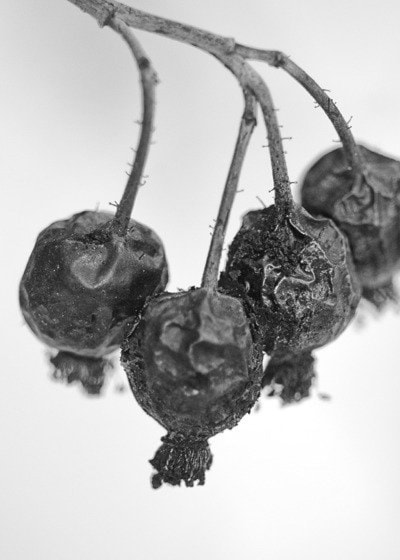Last September I wrote about how I like photographing my wife’s garden in every season and I didn’t really care about the weather conditions. I mention here that the more uninviting the elements, the better I like the photography.
The day here in the Interior of B.C., wasn’t really cold, it was only about -3° Celsius.
With a slightly overcast sky, I knew it would be perfect for photographing things poking out of the snow. I mounted my 200mm macro on my camera and connected a ring flash on that, and then stepped out into the snow-covered garden.
We’ve had lots of snow this winter, and if one digs down the soil is damp and unfrozen. The images I made last September were of dried out faded plants with a golden hue. But as I wandered around this time I found more than one green plant sticking out of the slowly melting snow. The deep, powdery snow that I had been photographing in all winter had turned crusty and no longer clung to the trees. There had been enough of a melt that I even could see some of the garden hose I forgot to put away last fall.
I mentioned that the overcast day was perfect for my subjects. Bright sunny days increase the contrast of scenes, especially snow covered ones, making it hard to capture details in the extremes, and I wanted to retain what details I could. The diffused daylight reduced the number of f/stops from black to white.
I used a ring flash. That is a flash that mounts around the front of a lens and can emit a soft direct light towards small subjects. When I add flash to a daylight scene I usually underexpose the ambient light and create fill light with the flash. My ring flash doesn’t have the TTL technology with which modern flash users are familiar. I must first determine the exposure, remembering that the shutter controls ambient light and flash intensity is controlled by the aperture. The flash is constant power, but can be full, quarter or sixteenth power output.
I began by photographing tall plants, but the small features poking out of, or just above the snow seemed more interesting, and instead of looking eye level I wandered searching the snow covered ground at my feet. I wandered around with my tripod searching the snow-covered garden for intriguing shapes.
I again ignored what books on garden photography recommend. I shot late in the day, not in the fresh morning light. Of course, spring is the most popular season for flower photography, but that is still months away, and, as I have written before, I doubt presenting winter photographs of shriveled lifeless plants to garden or photography clubs would be acceptable.
However, my photographs are more about colour and shape than of a garden environment
Just about anytime is good for a dedicated photographer to make photographs. My advice is to be creative, have fun, and don’t worry about failures. Open them up on the computer, learn something from them, then quickly delete.
Of course, some tweaking with PhotoShop always helps and, for those photographers that like me are trying for something different, anytime, and any conditions will be just fine.
These are my thoughts this week. Contact me at www.enmanscamera.com or emcam@telus.net. Stop by Enman’s Camera at 423 Tranquille Road in Kamloops. And if you want an experienced photographer please call me at 250-371-3069. I also sell an interesting selection of used photographic equipment.
